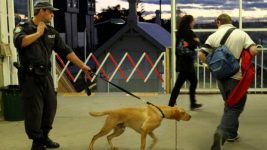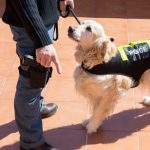Sniffer Dog Operations – Ineffective, Intrusive and Dangerous

Once again, figures obtained under the Government Information (Public Access) Act NSW 2009 suggest that the enormous amount of taxpayer funds and police resources invested into drug dog detection programs are not delivering dividends when it comes to addressing the illegal use of drugs.
Instead, they are resulting in thousands of people being subjected to intrusive bodily searches every year, while doing little to fulfil their stated purpose of deterring drug use and catching drug suppliers.
The statistics suggest that in 2015, NSW police carried out 12,893 bodily searches, of which 69 percent turned out to be false positives – where a dog makes an indication but no drugs are found during the subsequent search.
This means 8,874 law-abiding citizens were subjected to invasive public searches and in some instances, taken off to a room and strip searched.
The anti-sniffer dog campaign
The astounding level of false positives is nothing new. Since 2011, NSW Greens MLC David Shoebridge has been requesting figures from the police minister – and the percentage of searches that result in no illicit substances being found has remained around 70 percent.
Interestingly, the latest figures show a decline in the number of searches being carried out, and anti-sniffer dog advocates have put this down to the NSW Greens Sniff Off campaign. This grassroots movement is designed to raise awareness of the ineffectiveness of sniffer dogs operations.
The campaign runs the Sniff Off Facebook page, where members of the public can tip each other off about where police are carrying out drug dog operations. Needless to say, not all officers are overly impressed with the initiative, and three were caught trolling the page last year.
Sniffer dog legislation
The Police Powers (Drug Detection Dogs) Act NSW 2001, which came into force in February 2002, gave police the power to use sniffer dogs without any ‘reasonable suspicion’ of drug activity in places like pubs, entertainment centres and public transport stations.
Incidentally, NSW Greens MP Jenny Leong has been periodically introducing the Amendment (Sniffer Dogs-Repeal of Powers) Bill which, if passed, would revoke NSW police powers to carry out drug dog searches in places like train stations and music festivals.
Pre-loading and loading up
One of the main criticisms of sniffer dog operations is that they lead to drug users taking large quantities of drugs before arriving at venues (pre-loading) and taking their drugs all at once upon seeing sniffer dogs at a venue (loading up).
These dangerous activities have been linked to several deaths at Australian music festivals in recent years.
Case study: an unlawful search
The controversy surrounding sniffer dog operations is nothing new. Indeed, it predates the enactment of the Drug Detection Dogs Act.
Glen Darby was standing in front of the NV Nightclub on Sydney’s Oxford Street at 1.55 am on the morning of February 25, 2001. At that time, Senior Constable Richardson was patrolling the street with two other officers, as well as Rocky, a drug detection dog.
Mr Richardson claimed that Rocky flared his nostrils, sniffed at the air, then headed straight towards Mr Darby. The dog then began sniffing around the defendant’s genital area, bunting his head against Darby’s trousers and placing his nose on the outside of his pocket, before sitting down – which was a positive indication in the mind of the officer.
Drugs were indeed found, and Mr Darby was charged with possession of cannabis and methamphetamine.
In the local court, the presiding magistrate ruled that the actions of the dog constituted an unlawful search and that evidence of the drugs found thereafter should be excluded under the provisions of section 138 of the Evidence Act.
This meant police were left without evidence of drugs being found, and the charges were therefore dismissed.
Rocky went too far
After detecting the drugs, the dog sat down as officers began to search the defendant. It was also reported that Mr Darby produced a number of plastic bags from his pocket of his own volition.
In the absence of the provisions of the Drug Detection Act, the issue in dispute was whether the dog’s actions amounted to an actual search, or whether they were a mere indication of the presence of drugs which was – in combination with other factors – were sufficient to give police a ‘reasonable suspicion’ enabling Mr Darby to be searched.
Mr Darcy’s criminal defence lawyer argued that the dog’s actions went far beyond simply indicated the presence of drugs, and had amounted to a search – one which was not permitted by the law.
The magistrate’s ruling
The magistrate agreed with the defence, finding that actions of the dog amounted to an illegal search, and that the evidence of a subsequent finding of drugs should be excluded. The magistrate remarked:
“The prosecution has not persuaded me to exercise my discretion to admit the evidence obtained by means I have found to be improper and in contravention of the meaning of” section 37(4)(a) of the Drug Misuse and Trafficking Act NSW 1985, which provides:
“A member of the police force may stop, search and detain:
(a) any person in whose possession or under whose control the member reasonably suspects there is, in contravention of this Act, any prohibited plant or prohibited drug, or
(b) any vehicle in which the member reasonably suspects there is any prohibited plant or prohibited drug which is, in contravention of this Act, in the possession or under the control of any person”
The magistrate therefore dismissed the charges.
Incidentally, this section of the Drug Misuse and Trafficking Act NSW 1985 has since been repealed and replaced by search powers under section 21 of the Law Enforcement (Powers and Responsibilities) Act 2002 (the LEPRA).
DPP appeals the decision
The DPP appealed the local court ruling. Judge O’Keefe presided over the appeal and handed down his decision in May 2002. “In my opinion,” the judge remarked, “Rocky’s sniffing in the vicinity of the appellant, indicating that there was a scent without putting his nose on it, was not a search.”
His Honour found two errors with the magistrate’s findings. The first, he ruled, was that merely detecting an odour emanating from somewhere did not warrant a search.
The second was that Rocky’s bunting of Mr Darby did not amount to an illegal trespass, assault or battery as the magistrate had found.
He upheld the DPP’s appeal on that basis.
The second appeal
Mr Darby appealed that decision to the NSW Court of Appeal (NSWCA), where Justice Glass made the following remarks:
“[The canine] was pushing and ferreting at the appellant’s pockets with his nose, and was pursuing the appellant in the manner earlier described with the appellant attempting to push him away. At this stage the canine was doing what the officer could not do without authority. If Senior Constable Richardson had placed his hand on the appellant’s pocket, had pushed against it, had ferreted at it although not getting his hand in it, and when the appellant moved away had followed him and done the same the his actions would correctly be described as searching”.
The case was referred back to the local court for re-determination.
Keeping dog under control now legislated
By the time the rulings in Mr Darcy’s case had been handed down, the legislation governing NSW police drug dog operations was firmly in place.
Now, Section 150 of the LEPRA requires that:
(1) A police officer carrying out general drug detection must take all reasonable precautions to prevent the dog touching a person.
(2) A police officer is required to keep a dog under control when the officer is using the dog to carry out general drug detection.
If the officer fails to do this, the search may be illegal and evidence of any drugs found may be excluded under section 138 of the Evidence Act.
The Ombudsman’s report
In 2004, the NSW Ombudsman was asked to review the drug detection dog program, and he tabled his report two years later.
The report concluded that the NSW police sniffer dog program was a complete failure, with 73 percent of searches turning up false positives, most of the drugs found were only small amounts of cannabis, and the dogs hardly ever actually detected any dealers.
The Ombudsman was scathing in his criticism of the scheme, recommending its repeal. He additionally remarked that a mere indication by a sniffer dog is insufficient at law to allow police to search a person, relying upon the advice of Queen’s Counsel to support that finding.







